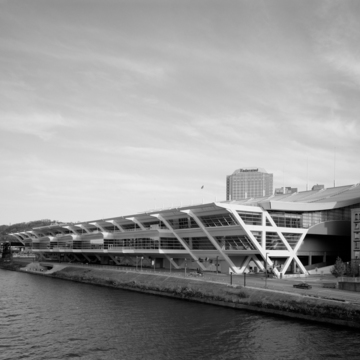Pittsburgh was no more sensitive in its treatment of its riverfront than were most American cities: the rivers of interest were rivers of commerce, and the only banks Pittsburghers cared about were made of marble and housed vaults. That was true for an earlier Lawrence Convention Center from the 1980s, a forbidding box that entirely turned its back on the Allegheny River. Since then, Pittsburgh created several new buildings that embrace and accentuate their riverside sites. The most intriguing of these is Rafael Viñoly's glazed catenary curve, which echoes three neighboring suspension bridges and eagerly thrusts its way toward the Allegheny River. The roof held by fifteen cables allows for unimpeded
Approximately half this complex is a parking garage, separated from the exhibition space by 10th Street, which still carries traffic through an arcade in the building. The upper part of the 10th Street arcade becomes a festive observation deck overlooking the river; the lower part is a ramp leading down to the water itself. The complex seems to reflect an awareness of its role as a historic nexus in American transportation history: here John A. Roebling's suspended aqueduct carried the barges of the old Pennsylvania Canal into the city 150 years before, and the main rail line between New





















